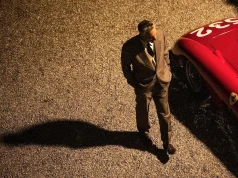
Red Tails squanders a great subject, reducing the real-life struggles and fierce heroics of the Tuskegee Airmen to rickety cliché. Some of the action is fun. But if something about that statement doesn’t sound right, well, there’s your chief problem with Red Tails. It sets out to ingratiate without provocation or complexity.
This much can be said of producer George Lucas’ long-gestating project: It avoids the aggravating Hollywood strategy of telling an African-American story by way of a mass-marketable white protagonist, a la the Civil War drama Glory.
But Lucas has overseen a movie divided against itself, part Clone Wars-aesthetic kicks, part dutiful sociology. The script, confining the action to 1944 Italy, places the occasional grown-up sentiment in a character’s mouth, as when one member of the 332nd Fighter Group tells another: “Don’t be in a hurry to get to the killing part.” Yet the movie can’t wait to get to the killing part, rendered here in computer-generated aerial dogfights a little too in love with the available filmmaking technology, and a little too uninterested in the characters doing the shooting.
The focus is on a fictional group of men stationed at Ramitelli Airfield. Hard-drinking squadron leader “Easy” Julian (Nate Parker) is the by-the-book contrast to his best friend, the Jedi whiz of the bunch, Joe “Lightning” Little (David Oyelowo). Coffee, the chief mechanic, is played by Andre Royo, one of several supporting players who worked with director Anthony Hemingway on The Wire. (Lucas himself directed the reshoots.) The marquee names belong to Terrence Howard and Cuba Gooding Jr., offering complementary portraits in unflappable leadership as a proud colonel and a pipe-smoking major, respectively.
Producer Lucas, director Hemingway and his writers, John Ridley and Boondocks creator Aaron McGruder, aren’t going for serious business here. As McGruder said in the film’s promotional materials, Red Tails offers “a comic-book feel that only George Lucas could bring to a film.” He added: “Before this, we didn’t have our John Wayne, but we now have that kind of larger-than-life treatment, and the Tuskegee Airmen deserve it.”
Yes, and they also deserve some dramatic vitality and plausibility. If you go to Red Tails to learn anything (even heavily fictionalized things) about the origin of the Tuskegee Airmen, or the workaday racism they had to endure, you will be disappointed. When Howard’s defiant colonel upbraids the Pentagon brass about their disdain for his men, the sequence is straight out of a comic book, per co-writer McGruder’s description. But if we can’t believe a scene such as this one would ever have happened that way, not in a million Earth years, then there’s no real gratification in it.
Little romances a local beauty, while Julian loses faith in his leadership skills. Sick of being sidelined and marginalized in the war, the men of the 332nd finally get the equipment and the approval they need to prove themselves in the air, primarily as protection for bombers delivering their payloads. But Red Tails runs into serious storytelling snags, particularly in its episodic second half.
The actors do all they can. But Lucas and company did not get the script right with this one, which is the single, dubious link Red Tails has to Indiana Jones and the Kingdom of the Crystal Skull.
—MCT, Tribune Media Service Respond: [email protected]














